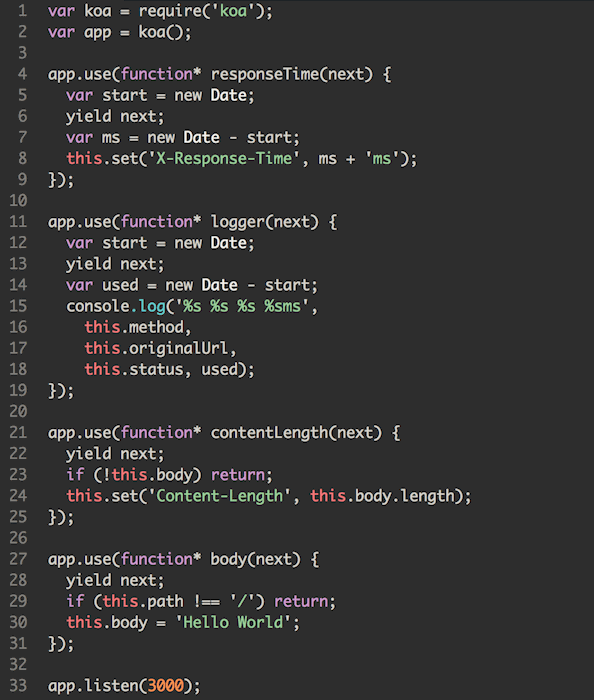Egg and Koa
# Asynchronous programming model
Node.js is an asynchronous world, asynchronous programming models in official API support are all in callback form ,it brings many problems. For example:
- callback hell: Notorious "callback hell"。
- release zalgo: Asynchronous functions may call callback function response data synchronously which would bring inconsistency.
The community has provided many solutions for the problems, the winner is Promise, it is built into ECMAScript 2015. On the basis of Promise, and with the ability of Generator to switch context, we can write asynchronous code in synchronous way with co and other third party libraries. Meanwhile async function, the official solution has been published in ECMAScript 2017 and landed in Node.js 8.
# Async function
Async function is a syntactic sugar at the language level. In async function, we can use await to wait for a promise to be resolved(or rejected, which will throw an exception), and Node.js LTS (8.x) has supported this feature.
const fn = async function() { |
# Koa
Koa is a new Web framework designed by the team behind Express, which aims to be a smaller, more expressive, and more robust foundation for Web applications and APIs.
The design styles of Koa and Express are very similar, The underlying basic library is the same, HTTP library. There are several significant differences between them. Besides the asynchronous solution by default mentioned above, there are the following points.
# Midlleware
The middleware in Koa is different from Express, Koa use the onion model:
- Middleware onion diagram:
- Middleware execution sequence diagram:

All the requests will be executed twice during one middleware. Compared to Express middleware, it is very easy to implement post-processing logic. You can obviously feel the advantage of Koa middleware model by comparing the compress middleware implementing in Koa and Express.
- koa-compress for Koa.
- compression for Express.
# Context
Unlike that there are only two objects Request and Response in Express, Koa has one more, Context object in one HTTP request(it is this in Koa 1, while it is the first parameter for middleware function in Koa 2). We can mount all the related properties in one request to this object. Such as traceId that runs through the whole request lifetime (which will be called anywhere afterward) could be mounted. It is more semantic other than request and response.
At the same time Request and Response are mounted to Context object. Just like Express, the two objects provide lots of easy ways to help developing. For example:
get request.queryget request.hostnameset response.bodyset response.status
# Exception handlering
Another enormous advantage for writing asynchronous code in synchronous way is that it is quite at ease to handle exception. You can catch all the exceptions thrown in the codes followed the convention with try catch. We can easily write a customized exception handling middleware.
async function onerror(ctx, next) { |
Putting this middleware before others, you can catch all the exceptions thrown by the synchronous or asynchronous code.
# Egg inherits from Koa
As described above, Koa is an excellent framework. However, it is not enough to build an enterprise-class application.
Egg is built around the Koa. On the basis of Koa model, Egg implements enhancements one step further.
# Extension
In the framework or application based on Egg, we can extend the prototype of 4 Koa objects by defining app/extend/{application,context,request,response}.js. With this, we can write more utility methods quickly. For example, we have the following code in app/extend/context.js:
// app/extend/context.js |
It can be used in controller then:
// app/controller/home.js |
More about extension, please check Exception section.
# Plugin
As is known to all, Many middlewares are imported to provide different kind of features in Express and Koa. Eg, koa-session provides the Session support, koa-bodyparser help to parse request body. Egg has provided a powerful plugin mechanism to make it easier to write stand alone features.
One plugin can include:
- extend:extend the context of base object, provide utility and attributes.
- middleware:add one or more middlewares, provide pre or post processing logic for request.
- config:configure the default value in different environments.
Stand alone module plugin can provide rich features with high maintenancability. You can almost forget the configuration as the plugin supports configuring the default value in different environments.
egg-security is a typical example.
More about plugin, please check Plugin section.
# Roadmap
# Egg 1.x
When Egg 1.x released, the Node.js LTS version did not support async function,so Egg 1.x was based on Koa 1.x. On the basis of this, Egg had added fully async function support. Egg is completely compatible with middlewares in Koa 2.x, all applications could write with async function.
- The underlying is based on Koa 1.x, asynchronous solution is based on generator function wrapped by co.
- Official plugin and core of Egg are written in generator function, keep supporting Node.js LTS version, use co when necessary to be compatiable with async function.
- Application developers can choose either async function (Node.js 8.x+) or generator function (Node.js 6.x+).
# Egg 2.x
When Node.js 8 became LTS version, async function could be used in Node.js without any performance problem. Egg released 2.x based on Koa 2.x, the framework and built-in plugins were all written by async function, and Egg 2.x still kept compatibility with generator function and all the usages in Egg 1.x, applications based on Egg 1.x can migrate to Egg 2.x only by upgrading to Node.js 8.
- The underlying will be based on Koa 2.x, asynchronous solution will be based on async function.
- Official plugin and core of egg will be written in async function.
- Recommend user to transfer business layer to async function.
- Only support Node.js 8+.